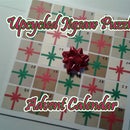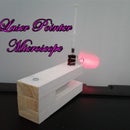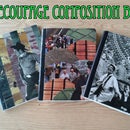Introduction: The Spring Bouquet- a Super Cheap DIY Spooky Sound Effects Device.
Recently Gizmodo ran a feature on the Electric Spring Doorstop from Slaparoo Percussion. It's a simple spring with a pickup and an audio jack built into a handle. You can run it through an effect pedal or two and get some really cool sounds. With Halloween coming up I have been looking for something new to add to my sound effects and noise arsenal so I decided to build my own.
I went to Home Depot and found three different sizes of doorstop springs so I decided to build something with multiple springs. I found an appropriate project box in my scrap pile and scrounged a few odds and ends from my workbench and built the Spring Bouquet- the perfect soundtrack for your haunted house or super villain lair.
Step 1: Materials.
You don't need much to build this.
-A few doorstop springs. Get them from the hardware store or steal them from your sister's room.
A box. Find something heavy to allow the springs to vibrate freely. If the base is too light the springs will dampen out quickly.
-A piezo disc. You can find them in broken alarm clocks and smoke detectors, toys or games that beep or Rock Band drum controllers.
-An audio jack. You could buy one from Radio Shack but who wants to give them any more money? Be creative. A good source of audio jacks is old broken audio gear. I know, what a pro tip.
Tools-
-A drill and bits. A basic hand drill is a must for drilling mounting holes.
-screw drivers.
-Hammer.
-Center punch.
-ruler.
-Marker.
To really enjoy this project you should also have an amplifier, some basic guitar effects pedals and cables. Reverb, delay, flanger, distortion and phaser are all good. Even the built in overdrive and spring delay in your amp will make this thing sound really cool. Just experiment and have fun.
Step 2: Drilling the Box.
I decided to use four springs so I needed to determine a good layout and mark the box for drilling. I used rulers and a Sharpie to mark the spring holes. I used a punch and a hammer to make a place to start drilling and drilled pilot holes with a thin bit. Next I drilled the holes to the final size and cleaned them up with a thin file. Since there was already a hole in the bottom section that I can use for the audio Jack I was done drilling.
Step 3: Mounting the Springs.
Now I wanted to install the springs and see how everything would fit. The three larger springs use a detachable base plate with a center hole for a mounting screw. I attached the base plates to the box lid with recycled hardware. The smaller spring has a built in screw in the base. I put this through the hole in the box lid and screwed a plywood disc on tightly from the inside to hold the small spring in place.
When all the springs were mounted tightly I tested the instrument out. The spacing and arrangement of the springs worked out just fine. I noticed that the lid didn't fit very tightly so it rattled when the big springs vibrated. As I played with the instrument I began to wonder how I could change the sound produced by the springs. I decided that a tighter lid and a better variety of sounds would need to be addressed in the final design. I disassembled the whole thing to prepare the box for painting.
Step 4: Painting and Setting Up the Box.
I wanted to spray paint the box so I gave it a good sanding to help the paint stick. I cleaned the box surface with alcohol and let it dry. I gave the bottom of the box several coats of satin black paint. I gave the lid a base coat of metallic silver followed by a couple of coats of silver glitter paint. When this was dry I applied the plumeria stencil from my stencil tutorial in shades of pink. I finished with a dusting of gold glitter and several coats of clear lacquer.
While I painted I thought about the lid. I happened to see a package of adhesive craft foam letters on the shelf in my shop and that gave me the solution. I used craft foam and two sided carpet tape to make a simple lid gasket to prevent the rattle. I also thought about how to alter the sonic qualities of the springs. Of course the sonic properties were tied to the physical characteristics of the spring. In this case the spring swings back and forth like a pendulum. This fast back and forth motion, or oscillation, is what produces the sound. By changing the speed or frequency of that oscillation we can change the sound it produces. Since our spring is basically acting like a pendulum, lets start there. The speed of a pendulum is determined by the length of the arm and the weight. Changing either of those values will change the speed of the pendulum. I decided that adding weight to the end of the spring was a good place to start.
When the paint was dry I added the foam gasket to the inside of the lid and installed the springs. I experimented with various weights and finally settled on several nuts threaded over the springs coupled with bolts threaded into the inside of the springs. This allowed me to slow the frequency of the springs oscillation quite a bit to create more of a rhythmic effect. So far I was very pleased with the project. Now it was time to add the pickup and audio jack.
Step 5: Wiring the Pickup.
I pulled a broken Rock Band drum controller out of the trash last year to salvage the piezo discs. I taped one of them to the underside of the lid with a thin silicone pad. I connected the wires to a two-connector piece of screw terminal. The bottom section of the box had a hole designed for connecting electrical conduit. I wanted to use this hole for my audio jack so I used two large washers, one on the inside and one on the outside, to sandwich the box wall and hold the jack in place. I connected the wires from the jack to the terminals and put the lid on. I secured the lid with two screws and I was done.
Step 6: So What's the Verdict?
Give it a listen-
I like it. This was just a quick demo but I definitely see potential in this device. I want to run it through some better effects and filters and record it direct to cut out the physical noise of the springs. I'd like to edit it to create leads, bass lines and rhythms. I see this device having a place in both traditional song structures and free form audio art. It will definitely help make my house the scariest sounding place in the neighborhood on Halloween.
I'll try to do a more refined track before Halloween for your spooky listening pleasure. Thanks for tuning in!

Participated in the
Halloween Decor Contest

Participated in the
Remix Contest

Participated in the
Superheroes and Supervillains Contest













